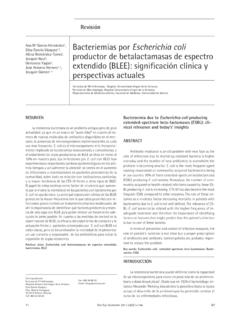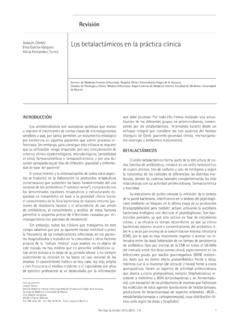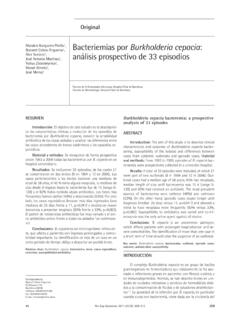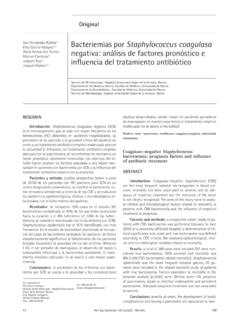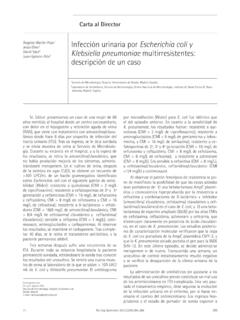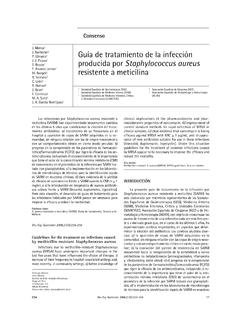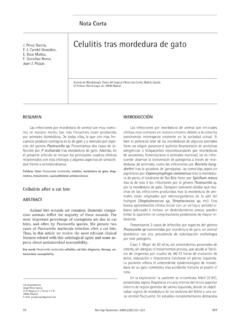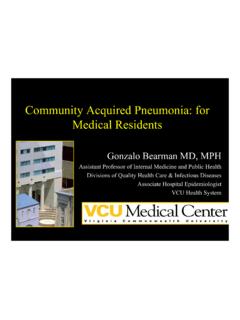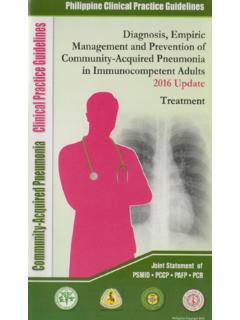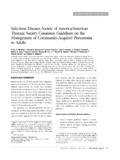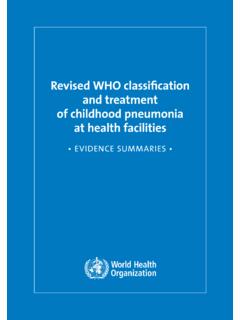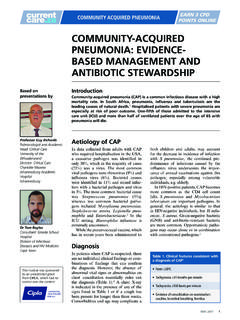Transcription of Guidelines for the management of community- acquired ...
1 Al envejecimiento y a una mayor presencia de enfermedades cr nicas. Debido a la importancia desde un punto de epidemi-ol gico y pron stico que tiene, y a la enorme heterogeneidad descrita en el manejo cl nico, creemos que exist a la necesidad de realizar un documento de consenso espec fico en este per-fil de paciente. El prop sito de ste fue realizar una revisi n de las evidencias en relaci n con los factores de riesgo para la etiolog a, la presentaci n cl nica, el manejo y el tratamien-to de la NAC en los ancianos con el fin de elaborar una serie de recomendaciones espec ficas basadas en el an lisis cr tico de la literatura.
2 Este documento es fruto de la colaboraci n de diferentes especialistas en representaci n de la Sociedad Espa ola de Medicina de Urgencias y Emergencias (SEMES), Sociedad Espa ola de Geriatr a y Gerontolog a (SEGG), Socie-dad Espa ola de Quimioterapia (SEQ), Sociedad Espa ola de Medicina Interna (SEMI), Sociedad Espa ola de Neumolog a y Cirug a Tor cica (SEPAR), Sociedad Espa ola de Hospitalizaci n a Domicilio (SEHAD) y Sociedad Espa ola de Enfermedades In-fecciosas y Microbiolog a Cl nica (SEIMC).Palabras clave: gu as, neumon a adquirida comunidad, anciano, diagn sti-co, tratamientoINTRODUCTIONThe incidence of community - acquired pneumonia (CAP) increases with age, reaching 25 to 35 cases per 1000 inhab-itants/year in the population over the age of 65 years.
3 This disease is associated with an elevated morbimortality and is a frequent cause of emergency care and hospital admission1-3. The elevated incidence of CAP in the elderly population has been related to a series of physiological changes associated with aging, the respiratory tract (reduction in cough reflex and mucociliary clearance) and the immune system (both innate and adaptative) together with a greater probability of clinical and social situations (edentulism, dysphagia, malnutrition, in-stitutionalization) and chronic disease accumulated with age (diabetes mellitus, chronic obstructive pulmonary disease, chronic heart failure, cancer and chronic renal insufficiency) which make the elderly more vulnerable to the development of infections, and more specifically to pneumonia, as well as to an increased risk of a worse incidence of community - acquired pneumonia (CAP)
4 Increases with age and is associated with an elevated mor-bimortality due to the physiological changes associated with aging and a greater presence of chronic disease. Taking into account the importance of this disease from an epidemiologi-cal and prognostic point of view, and the enormous heteroge-neity described in the clinical management of the elderly, we believe a specific consensus document regarding this patient profile is necessary. The purpose of the present work was to perform a review of the evidence related to the risk factors for the etiology, the clinical presentation, the management and the treatment of CAP in elderly patients with the aim of elab-orating a series of specific recommendations based on criti-cal analysis of the literature.
5 This document is the fruit of the collaboration of different specialists representing the Spanish Society of Emergency Medicine and Emergency Care (SEMES), the Spanish Society of Geriatrics and Gerontology (SEGG), the Spanish Society of Chemotherapy (SEQ), the Spanish Society of Internal Medicine (SEMI), the Spanish Society of Pneumol-ogy and Thoracic Surgery (SEPAR) and the Spanish Society of Home Hospitalization (SEHAD). Key words: Guidelines , community - acquired pneumonia, elderly, diagnosis, treatmentGu a de manejo de la neumon a adquirida en la comunidad en el ancianoRESUMENLa incidencia de la neumon a adquirida en la comunidad (NAC)
6 Se incrementa con la edad y se asocia a una elevada morbimortalidad debido a los cambios fisiol gicos asociados Guidelines for the management of community - acquired pneumonia in the elderly patient1 Sociedad Espa ola de Medicina de Urgencias y Emergencias2 Sociedad Espa ola de Geriatr a y Gerontolog a3 Sociedad Espa ola de Quimioterapia4 Sociedad Espa ola de Neumolog a y Cirug a Tor cica5 Sociedad Espa ola de Hospitalizaci n a Domicilio6 Sociedad Espa ola de Enfermedades Infecciosas y Microbiolog a Cl nica7 Sociedad Espa ola de Medicina Interna. Juan Gonz lez-Castillo1 Francisco Javier Mart n-S nchez2 Pedro Llinares3 Rosario Men ndez4 Abel Mujal5 Enrique Navas6 Jos Barber n7 Correspondence:Juan Gonz lez-CastilloServicio de Urgencias.
7 Hospital Cl nico San Carlos. Calle Profesor Mart n-Lagos s/n, 28040 Number: (34) 913303750 FAX Number: (34) 913303569E-mail: document69 Rev Esp Quimioter 2014;27(1): 69-86 With regard to the health care of elderly subjects, it is known that it is generally more complex, being associated with delays in the diagnosis and treatment, greater requests for complementary tests, elevated risk of adverse events, more prolonged hospital stay and a higher rate of hospital admis-sion compared to younger adults, thereby translating into a greater consumption of health care resources7.
8 Of the above make CAP in the elderly a first order health care problem considering the high prevalence and important clinical and health care consequences. Thus, despite the guide-lines and consensus documents published in relation to CAP7,8, the development of a consensus document with more specific approaches to CAP in this patient profile was considered neces-sary. This document is the fruit of the work of a group of experts representing several medical societies with the aim of establish-ing a series of specific recommendations related to the etiology, the clinical presentation and management of CAP in the elderly based on the scientific evidence available.
9 The elaboration of this consensus was carried out after requesting the participants to make a systematic search and a selection of good quality studies published and to establish a series of recommendations for daily clinical practice. Nonetheless, the clinical evidence available is limited, and therefore, many of the recommendations present-ed are based on the experience and the opinion of the experts themselves. Finally, a document was developed after the discus-sion and approval of all the members of the working group. CATEGORIZATION OF THE ELDERLY PATIENT All people 65 years of age or more are considered elderly.
10 This definition is based on purely sociological aspects, originat-ing a clinically very heterogeneous populational group. In this sense, the need to categorize the elderly has arisen and to do this a new concept has been introduced, that is, the frail elder-ly. This category is understood as a elderly person with greater vulnerability of having an adverse outcome with an acute pre-cipitating factor such as in the case of pneumonia. This state is explained by a diminishment in the physiological reserves as a consequence of aging and thus, of the accumulation of diseas-es over time which leads to a loss in the capacity of response to situations of stress.
